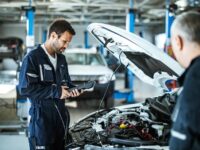HOW TO TROUBLESHOOT COMMON DRIVER MAINTENANCE ISSUES AT AUTOMOTIVE SHOPS
Keeping up with driver maintenance is crucial to keeping drivers safe on the road. However, like with any mechanical system, problems can arise that require troubleshooting. Here are some common driver maintenance issues that automotive shops may encounter and how to troubleshoot them:
Brake Problems
One of the most common driver maintenance issues at D Wells Auto is brake problems. If a customer complains of squeaky or soft brakes, this may indicate worn brake pads or a problem with the brake system. A mechanic should inspect the brake pads, calipers, and rotors for wear and damage. To address the issue, they may need to replace the brake pads or flush the brake fluid.
Engine Troubles
Various factors, including low oil levels, dirty air filters, and worn spark plugs, can cause engine troubles. A mechanic should check the oil level and replace the air filter if necessary. If the spark plugs are worn, they should be replaced to improve engine performance.
Battery Issues
A dead battery is a common driver maintenance issue. The mechanic should check the battery terminals for corrosion and clean them if necessary, and they should also test the battery voltage and replace it if necessary.
Transmission Problems
Transmission problems can cause the vehicle to jerk or hesitate when shifting gears. The mechanic should check the transmission fluid level and condition; they may need to replace the fluid and filter or make other repairs to the transmission.
Suspension Issues
Worn or damaged suspension components can cause a bumpy ride, excessive tire wear, and poor handling. A mechanic should inspect the shocks, struts, and other suspension components for wear and damage. They may need to replace worn parts to improve ride quality and handling.
Electrical Problems
Electrical problems can cause various issues, including dead batteries, malfunctioning lights, etc. A mechanic should inspect the electrical system for damaged or worn wiring and fuses; they may need to replace them to address the issue.
Fluid Leaks
Worn or damaged hoses, gaskets, or seals can cause fluid leaks. The mechanic should inspect the engine and transmission for leaks and replace any damaged parts. They may also need to clean the engine and transmission to identify the source of the leak.
Overheating
Overheating can be caused by various factors, including a malfunctioning cooling system, low coolant levels, or a faulty thermostat. A mechanic should inspect the cooling system for leaks and blockages, and they may need to flush the system and replace the coolant or replace a faulty thermostat to address the issue.
Fuel System Issues
Fuel system issues can cause the vehicle to stall, sputter, or run poorly. A mechanic should check the fuel filter and pump for wear and damage, and they may need to replace these parts to improve the vehicle’s performance.
Final words
Driver maintenance issues can be common in automotive shops, but proper troubleshooting and repairs can resolve them quickly and efficiently. A mechanic should inspect the vehicle thoroughly to identify the source of the issue and make the necessary repairs.







